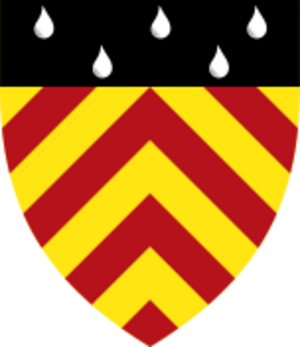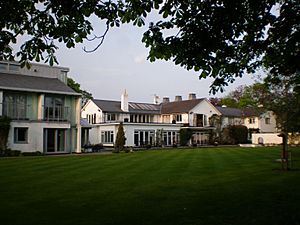Clare Hall, Cambridge facts for kids
Quick facts for kids Clare Hall |
||||||||||||||||
|---|---|---|---|---|---|---|---|---|---|---|---|---|---|---|---|---|
 |
||||||||||||||||

Arms of Clare Hall
|
||||||||||||||||
|
|
||||||||||||||||
| University | University of Cambridge | |||||||||||||||
| Location | Herschel Road (map) | |||||||||||||||
| Coordinates | 52°12′15″N 0°06′16″E / 52.2041°N 0.1045°E | |||||||||||||||
| Abbreviation | CLH | |||||||||||||||
| Established | 1966 | |||||||||||||||
| Named after | Clare College | |||||||||||||||
| Sister college | St Cross College, Oxford | |||||||||||||||
| President | Professor C. Alan Short | |||||||||||||||
| Undergraduates | None | |||||||||||||||
| Postgraduates | 255 (2022-23) | |||||||||||||||
| Map | ||||||||||||||||
Clare Hall is a special college at the University of Cambridge in England. It was started in 1966 by another college called Clare College. Clare Hall is different because it's only for students who are studying for advanced degrees, like master's or PhDs. It also welcomes researchers and professors.
This college began as a place for advanced studies. Over time, it grew into a full college within the university. Clare Hall is one of the smaller colleges. It has about 250 graduate students. But it also has around 125 fellows, who are senior academics. This means it has the highest number of fellows compared to students at Cambridge University.
Even though it's small, Clare Hall is known for having many people linked to it who have won Nobel Prizes. The college also keeps many old Cambridge traditions. These include special dinners called formal halls and a unique teaching method called the tutorial system.
Contents
History of Clare Hall
Clare Hall was created by Clare College. Clare College itself was once known as "Clare Hall" from 1338 to 1856. The idea for the new Clare Hall was to make a friendly place for men and women. It was also meant to have homes for their families.
The new college was planned for different groups of people. These included graduate students working on higher degrees. It also welcomed research fellows who had already earned their first degree. Plus, it was for permanent fellows who taught or researched at the university. Finally, it invited visiting fellows from universities all over the world.
In January 1964, Clare College decided to start this new center. A small group of fellows, led by Sir Eric Ashby, planned everything. They soon agreed to name the new center Clare Hall. This was the old name for Clare College itself. Clare Hall still has strong connections with Clare College. They sometimes share facilities and events.
The Institute of Advanced Studies at the University of Bologna in Italy is based on Clare Hall's model.
Buildings at Clare Hall
The famous architect Ralph Erskine designed the buildings for Clare Hall. These plans included common rooms, offices, and dining areas. There was also a house for the President and twenty apartments for visiting fellows. A nearby house, called Elmside, gave rooms to the graduate students.
Sir Eric Ashby, who was the head of Clare College at the time, officially opened Clare Hall in September 1969. Brian Pippard, the first President of Clare Hall, moved into the President's house. Twelve research students lived in Elmside. Many visiting fellows and their families moved into the new apartments.
Some early visiting fellows later won Nobel Prizes. Ivar Giaever won the Nobel Prize for Physics in 1973. Joseph Brodsky, a poet, won the Nobel Prize for Literature in 1987. William Nordhaus won the Nobel Prize for Economics in 2018.
The college also has a sports area. It includes a gym, a swimming pool, and a tennis court. There is also a dining room for formal dinners. The university's running track is close by.
How Clare Hall Grew
In 1978, the college bought another house nearby. It is now called Leslie Barnett House. This house provided more rooms for graduate students. This purchase also allowed new buildings, like the Michael Stoker and Brian Pippard Buildings, to be built. These added even more student rooms.
The Anthony Low Building was finished in 2000. It is in the garden of Elmside. This building has more common rooms and a bar for the graduate students.
In 1996, the college bought a large property. It used to be the family home of Lord Rothschild. This property is about a five-minute walk from the college. It was renamed Clare Hall West Court. After some changes, it now has public rooms, study areas, apartments, and more student rooms. It also has a fitness center and a swimming pool.
Student Life at Clare Hall
Clare Hall is different from other colleges. It doesn't have separate dining areas for senior members and students. Everyone eats together. All members also share the common rooms and other facilities. This helps students, visiting fellows, and senior members get to know each other. It also helps because people come from many different countries and have various research interests.
To help people connect, Clare Hall holds many events. These include college seminars and lunchtime discussions. There are also formal lecture series. One important series is about human values. It features a famous international scholar. Another is the annual Ashby lecture, given by a visiting fellow. There are also ASH seminars about arts, social sciences, and history.
Other events include art shows, movies, and small concerts. These add to the many music events available at the university.
People Connected to Clare Hall
Presidents of Clare Hall
The President of Clare Hall serves for seven years. Past presidents include Brian Pippard (1966–73), who was a physics professor. Sir Michael Stoker (1980–87) was a former director of a cancer research lab. Dame Gillian Beer (1994–2001) was a famous English literature professor. Ekhard Salje (2001–08) was head of Earth Sciences. Sir Martin Harris (2008–13) was a former head of the University of Manchester. David Ibbetson was a law professor.
Professor C. Alan Short became the ninth President of Clare Hall on August 1, 2020. He is a Professor of Architecture at the University of Cambridge.
Fellows of Clare Hall
Lord Ashby was the first honorary fellow of Clare Hall in 1975. Honorary fellows are people given special recognition.
Current honorary fellows include Kim Dae-Jung, a former President of South Korea. He won the Nobel Peace Prize in 2000. Lee Bollinger later became President of Columbia University. Retired presidents of the college are also honorary fellows. Ralph Erskine, who designed the early buildings, is also an honorary fellow.
Clare Hall is known for its strong work in theoretical physics. Brian Pippard, the first President, was a famous physics professor. Important current fellows include Michael Green, a former Lucasian Professor of Mathematics. John D. Barrow won the Templeton Prize. Stephen Toope was the Vice-Chancellor of the University from 2017.
Some past fellows who won Nobel Prizes include David J. Thouless (Physics, 2016) and Ivar Giaever (Physics, 1973).
Notable Alumni and Past Fellows
Many talented people have studied or worked at Clare Hall. Here are a few:
- Paul Berg, won the Nobel Prize in Chemistry in 1980.
- Joseph Brodsky, won the Nobel Prize in Literature in 1987.
- Jeff Colyer, a former Governor of Kansas in the USA.
- Kim Dae-jung, former President of South Korea, won the Nobel Peace Prize in 2000.
- Ivar Giaever, won the Nobel Prize in Physics in 1973.
- Seamus Heaney, won the Nobel Prize in Literature in 1995.
- William Nordhaus, won the Nobel Prize in Economics in 2018.
- David J. Thouless, won the Nobel Prize in Physics in 2016.
See also
- Clare Hall Boat Club
- Listed buildings in Cambridge (west)



